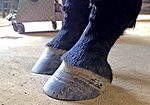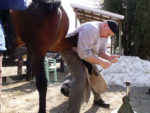Advertise Follow Us
Articles Tagged with ''high-low syndrome''
Recurring Hoof Deformities Are Trying To Tell You Something
Chronic flares, dished toes and underrun heels are often a sign of not properly addressing balance and conformation
Read More
From the Desk of AFJ
Share Your Most Common Hoof-Care Challenges
Searches of our website indicate high-low syndrome is No. 1
Read More
Tackling High-Low Syndrome From The High Side
Pennsylvania farrier finds focusing on getting upright hoof under control first helps bring the feet into closer symmetry
Read More
Taking a Closer Look at a Horse's Conformation
If you can't localize a subtle lameness, sometimes the key may be going back to the beginning.
Read More
Farriery From the ‘Whole Horse’ Approach
The cause of many hoof-care problems that farriers face may not actually lie in the foot
Read More
Balance, Symmetry Lead To Better Movement
Florida farrier finds solid, basic approach works best
Read More
Taking On Club Feet And High-Low Syndrome
New Jersey farrier says understanding cause and effect is key to treating these conditions in adult horses
Read More












